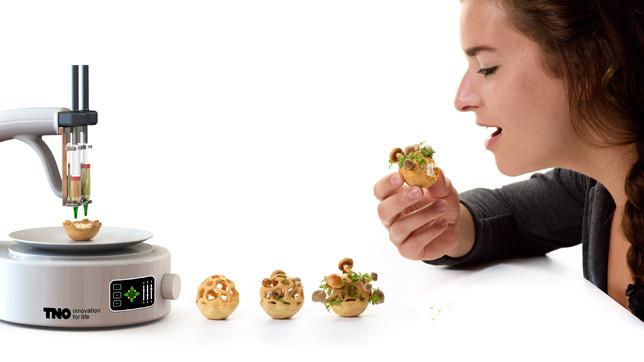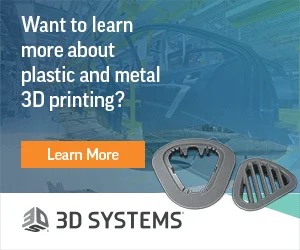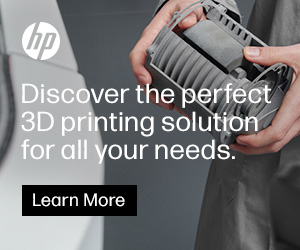Do We Want 3D Printed Snacks?
 The wave of things that people want to 3D print has grown to tsunami proportions. We’ve seen stories about printed organs, printed engines, and printed lingerie. It doesn’t take too much imagination, and perhaps a little history of watching Star Trek, to become really excited about the idea of 3D printed food. The fantasy is that one day, in some nearish/not-so-distant future we could walk into our kitchens, pour a cup of coffee or tea (Earl Grey. Hot.) (brewed automatically), pull a plate out of a dishwasher/storage-drawer, and head over to our home food printer to program a morning of lobster eggs Benedict with a side of home fries.
The wave of things that people want to 3D print has grown to tsunami proportions. We’ve seen stories about printed organs, printed engines, and printed lingerie. It doesn’t take too much imagination, and perhaps a little history of watching Star Trek, to become really excited about the idea of 3D printed food. The fantasy is that one day, in some nearish/not-so-distant future we could walk into our kitchens, pour a cup of coffee or tea (Earl Grey. Hot.) (brewed automatically), pull a plate out of a dishwasher/storage-drawer, and head over to our home food printer to program a morning of lobster eggs Benedict with a side of home fries.
If you really understand 3D printing, you may already be rolling your eyes. It’s true that 3D printers have been and are being used to produce edible products, most notably chocolates and other confections, however there is a significant amount of debate over the merits and possibilities, or lack thereof, that are present in such a food production techniques. A lot of the investment in or revulsion from the idea of 3D printing food is derived from individual philosophy. In fact, it arises when asking one of the most basic questions of philosophy which is “Where does everything come from?”
 3D printing food leads us down this philosophical path because it requires that food be reduced to its most basic elements, just as printing reduces color to its four components: cyan, magenta, yellow, and black. Is it possible to reduce food to some basic ‘inks’, a combination of which could hypothetically lead to the creation of any food substance? Is the creation of food science or is it art? Is there something greater than just the ingredients, some je ne sais quoi that must be present to change nutritional substances into food?
3D printing food leads us down this philosophical path because it requires that food be reduced to its most basic elements, just as printing reduces color to its four components: cyan, magenta, yellow, and black. Is it possible to reduce food to some basic ‘inks’, a combination of which could hypothetically lead to the creation of any food substance? Is the creation of food science or is it art? Is there something greater than just the ingredients, some je ne sais quoi that must be present to change nutritional substances into food?
A bigger question here is: is there anything necessary that is added by 3D printing the food rather than making it in some other way? The technology is wonderful in that it has democratized making, eliminated enormous initial investments, created limitless potential for customization, can produce things incredibly rapidly…but are these possibilities important to food production? And this is a key question for 3D printing in general as it struggles to move its identity from nifty novelty to commonly accepted workhorse. Just because something can be 3D printed doesn’t mean it should be. On the other hand, it’s hard to resist the urge to see what can be done, even if it turns out, in the long run, to be wholly unnecessary.
 In other words, this may or may not be the best idea since sliced bread, but the continued exploration of how food is produced has enormous potential to address significant nutrition and dietary issues the world wide. I’m not sure the creation of Cheez-E Snack Units (trademark me) is the best way to utilize our advanced technology, but the basic science behind such explorations could lead in any number of directions.
In other words, this may or may not be the best idea since sliced bread, but the continued exploration of how food is produced has enormous potential to address significant nutrition and dietary issues the world wide. I’m not sure the creation of Cheez-E Snack Units (trademark me) is the best way to utilize our advanced technology, but the basic science behind such explorations could lead in any number of directions.
It’s not that I’m a luddite, and I am always excited about eating, but I just don’t know if I have the patience to eat my way through another molecular gastronomy-type foodie movement. Let’s discuss this topic over in the 3D Printed Snacks or Not? forum at 3DPB.com.
Subscribe to Our Email Newsletter
Stay up-to-date on all the latest news from the 3D printing industry and receive information and offers from third party vendors.
You May Also Like
Simulation Complete: Pioneer Crew Wraps Up Year-Long Mission in 3D Printed Mars Habitat
After 378 days of living in a Mars-like 3D printed habitat, NASA’s Crew Health and Performance Exploration Analog (CHAPEA) crew emerged on July 6, 2024, bringing with them vital insights...
Alquist 3D Learns Some Lessons for the Construction 3D Printing Industry
The demolition of a home 3D printed by Alquist 3D spread like wildfire when it was reported last winter. While many took the opportunity to express their skepticism over additive...
Texas Cracks Down on Illegal Gun Switches, Including 3D Printed Ones
Texas has unveiled Operation Texas Kill Switch, a new initiative to target illegal machine gun-conversion devices, commonly known as “switches.” These tiny devices, often no bigger than an inch, can...
UK Utility Company Launches Hub for Wastewater “Printfrastructure”
With homebuilding serving as the primary marketing vehicle for additive construction (AC), we’re starting to see concrete 3D printing further drive its way into other areas of the architecture, engineering,...
































